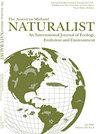Are There Differences in Select Ecological Attributes and Reproductive Output of Yearling Female Cooper's Hawks (Accipiter cooperii) Breeding in Urban vs. Rural Landscapes in Wisconsin?
IF 0.6
4区 环境科学与生态学
Q4 Agricultural and Biological Sciences
引用次数: 1
Abstract
Abstract. Cooper's Hawks (Accipiter cooperii) nest commonly in various habitats throughout North America, but there are few comparative studies of the ecology of urban vs. rural nesting birds, especially regarding 1 y olds whose inexperience is purported to place them under different selective pressures than more commonly nesting hawks ≥ 2 y of age. Notably, selective pressures of cities have prompted recent changes in the life histories and phenotypes of urban birds, and some of these pressures may be age dependent. We investigated select intrinsic properties of individuals and reproductive output of breeding yearling females and their mates for potential differences in the ecology of urban vs. rural birds in Wisconsin, 1980–2017. We found no differences in mean body mass of yearling females, their male mates, nesting phenology, nor in average clutch or brood counts in urban vs. rural Cooper's Hawks. Excluding one instance, yearling females were mated to older males, ≥ 2 y of age, and within 33 pairs birds mated by like sizes (small/small, etc.). Sums of masses for paired birds were not correlated with their brood sizes, in contrast to our earlier findings on the same study areas where brood size was positively and significantly correlated with summed masses of paired birds ≥ 2 y old who also mated by similar size. We call for more comparative studies of Cooper's Hawks in cities < 100,000 people as studied herein, as most research on urban nesting Cooper's Hawks stem from large, metropolitan cities with about 1 million people, which are less prevalent than smaller cities as we investigated. Indeed, there is growing evidence worldwide that the types and strength of selective pressures on urban wildlife is greater in larger cities, yet less is known about small cities.威斯康辛州城市景观与乡村景观中雌库柏鹰(Accipiter cooperii)的选择生态属性和繁殖产量是否存在差异?
摘要库柏鹰(Accipiter cooperii)在北美各地的各种栖息地筑巢,但很少有城市与农村筑巢鸟的生态学比较研究,特别是关于1岁的雏鸟,其缺乏经验据称使它们面临不同的选择压力,而不是更常见的筑巢鹰≥2岁。值得注意的是,城市的选择压力促使城市鸟类的生活史和表型发生了变化,其中一些压力可能与年龄有关。1980-2017年,我们调查了威斯康星州城市与农村鸟类生态的潜在差异,研究了个体的选择内在特性和繁殖一岁雌性及其配偶的繁殖产出。我们发现,在城市和农村的库柏鹰中,一岁雌鹰的平均体重、雄鹰配偶的平均体重、筑巢物候、平均窝数和窝数都没有差异。除1例外,33对雏鸟均与年龄≥2岁的老年雄鸟交配(小/小等)。与我们之前在相同研究区域的发现相反,配对鸟类的质量总和与它们的育雏规模不相关,育雏规模与年龄≥2岁且交配规模相似的配对鸟类的质量总和呈正相关。我们呼吁在这里研究的人口小于10万人的城市中对库珀鹰进行更多的比较研究,因为大多数关于库珀鹰在城市筑巢的研究都来自大约100万人口的大城市,在我们的调查中,这些城市的流行程度不如小城市。事实上,世界范围内越来越多的证据表明,大城市对城市野生动物的选择压力的类型和强度更大,但对小城市的了解却很少。
本文章由计算机程序翻译,如有差异,请以英文原文为准。
求助全文
约1分钟内获得全文
求助全文
来源期刊

American Midland Naturalist
环境科学-生态学
CiteScore
1.20
自引率
0.00%
发文量
38
审稿时长
18-36 weeks
期刊介绍:
The American Midland Naturalist has been published for 90 years by the University of Notre Dame. The connotations of Midland and Naturalist have broadened and its geographic coverage now includes North America with occasional articles from other continents. The old image of naturalist has changed and the journal publishes what Charles Elton aptly termed "scientific natural history" including field and experimental biology. Its significance and breadth of coverage are evident in that the American Midland Naturalist is among the most frequently cited journals in publications on ecology, mammalogy, herpetology, ornithology, ichthyology, parasitology, aquatic and invertebrate biology and other biological disciplines.
 求助内容:
求助内容: 应助结果提醒方式:
应助结果提醒方式:


